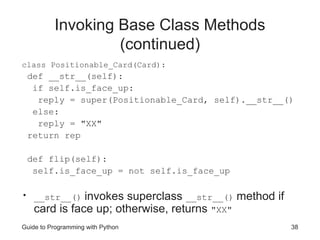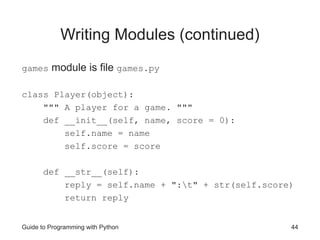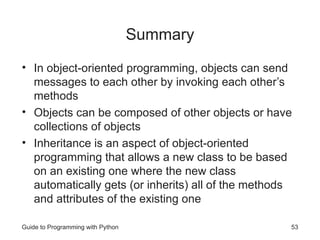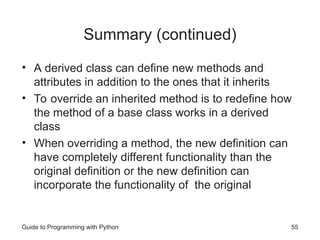Programming in python and introduction.ppt
- 1. Guide to Programming with Python Chapter Nine Object-Oriented Programming: The Blackjack Game
- 2. Guide to Programming with Python 2 Objectives • Create objects of different classes in the same program • Allow objects to communicate with each other • Create more complex objects by combining simpler ones • Derive new classes from existing ones • Extend the definition of existing classes • Override method definitions of existing classes
- 3. Guide to Programming with Python 3 The Blackjack Game Figure 9.1: Sample run of the Blackjack game One player wins, the other is not so lucky.
- 4. Guide to Programming with Python 4 Sending and Receiving Messages • Object-oriented program like an ecosystem • Objects like organisms • Organisms interact and so do objects • Message: Communication between objects; one object sends another a message when it invokes a method of the other
- 5. Guide to Programming with Python 5 The Alien Blaster Program Figure 9.2: Sample run of the Alien Blaster program Battle description is result of objects exchanging message.
- 6. Guide to Programming with Python 6 The Alien Blaster Program (continued) Figure 9.3: Visual representation of objects exchanging a message hero, a Player object, sends invader, an Alien object, a message.
- 7. Guide to Programming with Python 7 The Alien Blaster Program (continued) class Player(object): def blast(self, enemy): print "The player blasts an enemy." enemy.die() class Alien(object): def die(self): print "Good-bye, cruel universe." hero = Player() invader = Alien() hero.blast(invader)
- 8. Guide to Programming with Python 8 Sending a Message class Player(object): def blast(self, enemy): print "The player blasts an enemy." enemy.die() ... hero.blast(invader) • hero.blast() method is passed invader; i.e., the Player blast() method is passed an Alien object • In blast(), enemy refers to the Alien object (invader) • blast() invokes the Alien object’s die() method; i.e., the Player object sends the Alien object a message telling it to die alien_blaster.py
- 9. Guide to Programming with Python 9 Combining Objects • Real-world objects are often made up of other objects • Can mimic composition and collection in OOP • Drag racer composed of body, tires, and engine – Drag_Racer class with attribute engine that is a Race_Engine object • Zoo is collection of animals – Zoo class that has an attribute animals which is a list of different Animal objects
- 10. Guide to Programming with Python 10 The Playing Cards Program Figure 9.4: Sample run of the Playing Cards program Each Hand object has a collection of Card objects.
- 11. Guide to Programming with Python 11 Creating the Card Class class Card(object): """ A playing card. """ RANKS = ["A", "2", "3", "4", "5", "6", "7", "8", "9", "10", "J", "Q", "K"] SUITS = ["c", "d", "h", "s"] def __init__(self, rank, suit): self.rank = rank self.suit = suit def __str__(self): reply = self.rank + self.suit return reply
- 12. Guide to Programming with Python 12 Creating the Card Class (continued) • Card object rank attribute represents rank of card – RANKS class attribute has all possible values – "A" ace, "J" jack, "Q" queen, "K" king, "2" - "10" numeric values • Card object suit attribute represents suit of card – SUITS class attribute has all possible values – "c" clubs, "d" diamonds, "h" hearts, "s" spades • A Card object with rank "A" and suit "d" is the ace of diamonds
- 13. Guide to Programming with Python 13 Creating the Hand Class class Hand(object): """ A hand of playing cards. """ def __init__(self): self.cards = [] def __str__(self): if self.cards: reply = "" for card in self.cards: reply += str(card) + " " else: reply = "<empty>" return reply
- 14. Guide to Programming with Python 14 Creating the Hand Class (continued) def clear(self): self.cards = [] def add(self, card): self.cards.append(card) def give(self, card, other_hand): self.cards.remove(card) other_hand.add(card)
- 15. Guide to Programming with Python 15 Creating the Hand Class (continued) • Attribute – cards is list of Card objects • Methods – __str__() returns string for entire hand – clear() clears list of cards – add() adds card to list of cards – give() removes card from current hand and adds to another hand
- 16. Guide to Programming with Python 16 Using Card Objects card1 = Card(rank = "A", suit = "c") card2 = Card(rank = "2", suit = "c") card3 = Card(rank = "3", suit = "c") card4 = Card(rank = "4", suit = "c") card5 = Card(rank = "5", suit = "c") print card1 # Ac print card2 # 2c print card3 # 3c print card4 # 4c print card5 # 5c
- 17. Guide to Programming with Python 17 Combining Card Objects Using a Hand Object my_hand = Hand() print my_hand # <empty> my_hand.add(card1) my_hand.add(card2) my_hand.add(card3) my_hand.add(card4) my_hand.add(card5) print my_hand # Ac 2c 3c 4c 5c
- 18. Guide to Programming with Python 18 Combining Card Objects Using a Hand Object (continued) your_hand = Hand() my_hand.give(card1, your_hand) my_hand.give(card2, your_hand) print your_hand # Ac 2c print my_hand # 3c 4c 5c my_hand.clear() print my_hand # <empty> playing_cards.py
- 19. Guide to Programming with Python 19 Using Inheritance to Create New Classes • Inheritance: An element of OOP that allows a new class to be based on an existing one where the new automatically gets (or inherits) all of the methods and attributes of the existing class • Like getting all the work that went into the existing class for free
- 20. Guide to Programming with Python 20 Extending a Class Through Inheritance • Inheritance is used to create a more specialized version of an existing class • The new class gets all the methods and attributes of the existing class • The new class can also define additional methods and attributes • Drag_Racer class with methods stop() and go() • Clean_Drag_Racer based on Drag_Racer() – Automatically inherits stop() and go() – Can define new method, clean(), for cleaning windshield
- 21. Guide to Programming with Python 21 The Playing Cards 2.0 Program Figure 9.5: Sample run of the Playing Cards 2.0 program The Deck object inherits all of the methods of the Hand class.
- 22. Guide to Programming with Python 22 Creating a Base Class (Same as before) class Hand(object): """ A hand of playing cards. """ def __init__(self): self.cards = [] def __str__(self): if self.cards: reply = "" for card in self.cards: reply += str(card) + " " else: reply = "<empty>" return rep
- 23. Guide to Programming with Python 23 Creating a Base Class (continued) (Same as before) def clear(self): self.cards = [] def add(self, card): self.cards.append(card) def give(self, card, other_hand): self.cards.remove(card) other_hand.add(card)
- 24. Guide to Programming with Python 24 Inheriting from a Base Class class Deck(Hand): • Base class: A class upon which another is based; it is inherited from by a derived class • Derived class: A class that is based upon another class; it inherits from a base class • Hand is base class • Deck is derived class
- 25. Guide to Programming with Python 25 Inheriting from a Base Class (continued) • Deck inherits Hand attribute: cards • Deck inherits all Hand methods: __init__() __str__() clear() add() give()
- 26. Guide to Programming with Python 26 Extending a Derived Class class Deck(Hand): """ A deck of playing cards. """ def populate(self): for suit in Card.SUITS: for rank in Card.RANKS: self.add(Card(rank, suit)) def shuffle(self): import random random.shuffle(self.cards)
- 27. Guide to Programming with Python 27 Extending a Derived Class (continued) def deal(self, hands, per_hand = 1): for rounds in range(per_hand): for hand in hands: if self.cards: # if len(self.cards) > 0 top_card = self.cards[0] self.give(top_card, hand) else: print "Out of cards!"
- 28. Guide to Programming with Python 28 Extending a Derived Class (continued) • In addition to methods Deck inherits, it defines new methods: populate() shuffle() deal()
- 29. Guide to Programming with Python 29 Using the Derived Class deck1 = Deck() print deck1 # <empty> deck1.populate() print deck1 # ordered deck deck1.shuffle() print deck1 # shuffled deck
- 30. Guide to Programming with Python 30 Using the Derived Class (continued) my_hand = Hand() your_hand = Hand() hands = [my_hand, your_hand] deck1.deal(hands, per_hand = 5) print my_hand # 5 alternating cards from deck print your_hand # 5 alternating cards from deck print deck1 # deck minus first 10 cards deck1.clear() print deck1 # <empty> playing_cards2.py
- 31. Guide to Programming with Python 31 Altering the Behavior of Inherited Methods • Override: To redefine how inherited method of base class works in derived class • Two choices when overriding – Completely new functionality vs. overridden method – Incorporate functionality of overridden method, add more
- 32. Altering the Behavior of Inherited Methods (continued) • Drag_Racer with stop() method that applies brakes • Parachute_Racer based on Drag_Racer overrides stop() method, two choices – Overridden stop() method shifts into reverse – Overridden stop() method applies brakes (using the overridden method) and releases parachute Guide to Programming with Python 32
- 33. Guide to Programming with Python 33 The Playing Cards 3.0 Program Figure 9.6: Sample run of the Playing Cards program By overriding __str__(), objects of derived classes print differently.
- 34. Guide to Programming with Python 34 Creating a Base Class (Same as before) class Card(object): """ A playing card. """ RANKS = ["A", "2", "3", "4", "5", "6", "7", "8", "9", "10", "J", "Q", "K"] SUITS = ["c", "d", "h", "s"] def __init__(self, rank, suit): self.rank = rank self.suit = suit def __str__(self): reply = self.rank + self.suit return reply
- 35. Guide to Programming with Python 35 Overriding Base Class Methods class Unprintable_Card(Card): .... def __str__(self): return "<unprintable>" • Unprintable_Card – Inherits all methods of Card – Overrides inherited method __str__() – Printed object displayed as <unprintable> • A derived class has no effect on a base class
- 36. Guide to Programming with Python 36 Invoking Base Class Methods • In overridden method, can incorporate inherited method’s functionality • Suppose we want to have a card that can be face up or face down… class Positionable_Card(Card): def __init__(self, rank, suit, face_up = True): super(Positionable_Card, self).__init__(rank, suit) self.is_face_up = face_up • Superclass: Another name for a base class • Card is the superclass of Positionable_Card
- 37. Guide to Programming with Python 37 Invoking Base Class Methods (continued) • Incorporate inherited method’s functionality by calling super() • Positionable_Card constructor invokes Card constructor and creates new attribute • super() lets you invoke the method of a superclass – First argument is the base class, Positionable_Card – Second is a reference to the object itself, self – Last is the superclass method you want to call with its parameters, __init__(rank, suit)
- 38. Guide to Programming with Python 38 Invoking Base Class Methods (continued) class Positionable_Card(Card): def __str__(self): if self.is_face_up: reply = super(Positionable_Card, self).__str__() else: reply = "XX" return rep def flip(self): self.is_face_up = not self.is_face_up • __str__() invokes superclass __str__() method if card is face up; otherwise, returns "XX"
- 39. Guide to Programming with Python 39 Using the Derived Classes card1 = Card("A", "c") card2 = Unprintable_Card("A", "d") card3 = Positionable_Card("A", "h") print card1 # Ac print card2 # <unprintable> print card3 # Ah card3.flip() print card3 # XX playing_cards3.py
- 40. Guide to Programming with Python 40 Understanding Polymorphism • Polymorphism: Aspect of object-oriented programming that allows you to send same message to objects of different classes, related by inheritance, and achieve different but appropriate results for each object • When you invoke __str__() method of Unprintable_Card object, you get different result than when you invoke the __str__() method of a Card object
- 41. Guide to Programming with Python 41 Creating Modules • Create, use, and even share your own modules • Reuse code – Could reuse the Card, Hand, and Deck classes for different card games • Manage large projects – Professional projects can be hundreds of thousands of lines long – Would be nearly impossible to maintain in one file
- 42. Guide to Programming with Python 42 The Simple Game Program Figure 9.7: Sample run of the Simple Game program Program uses functions and class from programmer-created module.
- 43. Guide to Programming with Python 43 Writing Modules • Write module as a collection of related programming components, like functions and classes, in single file • File is just Python file with extension .py • Module imported using filename, just like built-in modules
- 44. Guide to Programming with Python 44 Writing Modules (continued) games module is file games.py class Player(object): """ A player for a game. """ def __init__(self, name, score = 0): self.name = name self.score = score def __str__(self): reply = self.name + ":t" + str(self.score) return reply
- 45. Guide to Programming with Python 45 Writing Modules (continued) def ask_yes_no(question): """Ask a yes or no question.""" response = None while response not in ("y", "n"): response = raw_input(question).lower() return response def ask_number(question, low, high): """Ask for a number within a range.""" response = None while response not in range(low, high): response = int(raw_input(question)) return response
- 46. Guide to Programming with Python 46 Writing Modules (continued) if __name__ == "__main__": print "You ran module but must 'import' it." raw_input("nnPress the enter key to exit.") • __name__ == "__main__" is true if file is run directly; is false if the file is imported as module • If games.py run directly, message displayed that the file is meant to be imported games.py
- 47. Guide to Programming with Python 47 Importing Modules import games, random • Import programmer-created module the same way you import a built-in module
- 48. Guide to Programming with Python 48 Using Imported Functions and Classes num = games.ask_number(question = "How many?", low = 2, high = 5) ... player = games.Player(name, score) ... again = games.ask_yes_no("Play again? (y/n): ") • Use imported programmer-created modules the same way as you use imported built-in modules simple_game.py
- 49. Guide to Programming with Python 49 The Blackjack Game - Classes Table 9.1: Blackjack classes
- 50. Guide to Programming with Python 50 The Blackjack Game – Class Hierarchy Figure 9.8: Blackjack classes Inheritance hierarchy of classes for the Blackjack game
- 51. Guide to Programming with Python 51 The Blackjack Game - Pseudocode Deal each player and dealer initial two cards For each player While the player asks for a hit and the player is not busted Deal the player an additional card If there are no players still playing Show the dealer’s two cards Otherwise While the dealer must hit and the dealer is not busted Deal the dealer an additional card If the dealer is busted For each player who is still playing The player wins
- 52. Guide to Programming with Python 52 The Blackjack Game – Pseudocode (continued) Otherwise For each player who is still playing If the player’s total is greater than the dealer’s total The player wins Otherwise, if the player’s total is less than the dealer’s total The player loses Otherwise The player pushes blackjack.py
- 53. Guide to Programming with Python 53 Summary • In object-oriented programming, objects can send messages to each other by invoking each other’s methods • Objects can be composed of other objects or have collections of objects • Inheritance is an aspect of object-oriented programming that allows a new class to be based on an existing one where the new class automatically gets (or inherits) all of the methods and attributes of the existing one
- 54. Summary (continued) • Inheritance can be used to create a more specialized version of an existing class • A base class is a class upon which another is based; it is inherited from by this other class (the derived class) • A derived class is a class that is based upon another class; it inherits from this other class (a base class) • Superclass is another name for base class Guide to Programming with Python 54
- 55. Guide to Programming with Python 55 Summary (continued) • A derived class can define new methods and attributes in addition to the ones that it inherits • To override an inherited method is to redefine how the method of a base class works in a derived class • When overriding a method, the new definition can have completely different functionality than the original definition or the new definition can incorporate the functionality of the original
- 56. Guide to Programming with Python 56 Summary (continued) • The super() function allows you to invoke the method of a superclass • Polymorphism is an aspect of object-oriented programming that allows you to send the same message to objects of different classes, related by inheritance, and achieve different but appropriate results for each object • You can write, import, and even share your own modules
- 57. Summary (continued) • You write a module as a collection of related programming components, like functions and classes, in a single Python file • Programmer-created modules can be imported the same way that built-in modules are, with an import statement • You test to see if __name__ is equal to "__main__" to make a module identify itself as such Guide to Programming with Python 57


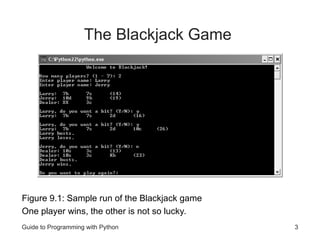





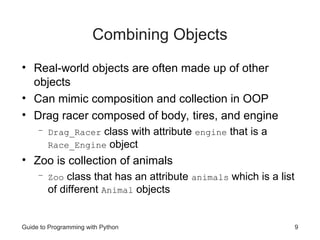

![Guide to Programming with Python 11
Creating the Card Class
class Card(object):
""" A playing card. """
RANKS = ["A", "2", "3", "4", "5", "6", "7",
"8", "9", "10", "J", "Q", "K"]
SUITS = ["c", "d", "h", "s"]
def __init__(self, rank, suit):
self.rank = rank
self.suit = suit
def __str__(self):
reply = self.rank + self.suit
return reply](https://image.slidesharecdn.com/ch09-241018043703-f8fb98a9/85/Programming-in-python-and-introduction-ppt-11-320.jpg)

![Guide to Programming with Python 13
Creating the Hand Class
class Hand(object):
""" A hand of playing cards. """
def __init__(self):
self.cards = []
def __str__(self):
if self.cards:
reply = ""
for card in self.cards:
reply += str(card) + " "
else:
reply = "<empty>"
return reply](https://image.slidesharecdn.com/ch09-241018043703-f8fb98a9/85/Programming-in-python-and-introduction-ppt-13-320.jpg)
![Guide to Programming with Python 14
Creating the Hand Class (continued)
def clear(self):
self.cards = []
def add(self, card):
self.cards.append(card)
def give(self, card, other_hand):
self.cards.remove(card)
other_hand.add(card)](https://image.slidesharecdn.com/ch09-241018043703-f8fb98a9/85/Programming-in-python-and-introduction-ppt-14-320.jpg)
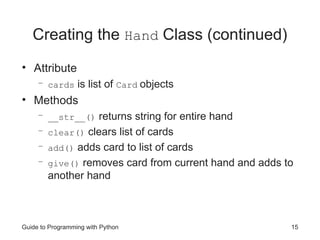



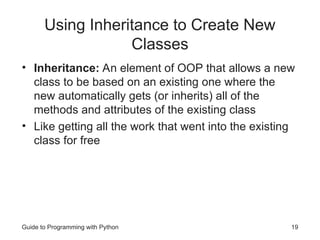
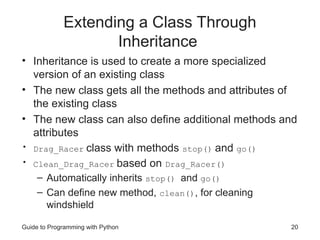

![Guide to Programming with Python 22
Creating a Base Class
(Same as before)
class Hand(object):
""" A hand of playing cards. """
def __init__(self):
self.cards = []
def __str__(self):
if self.cards:
reply = ""
for card in self.cards:
reply += str(card) + " "
else:
reply = "<empty>"
return rep](https://image.slidesharecdn.com/ch09-241018043703-f8fb98a9/85/Programming-in-python-and-introduction-ppt-22-320.jpg)
![Guide to Programming with Python 23
Creating a Base Class (continued)
(Same as before)
def clear(self):
self.cards = []
def add(self, card):
self.cards.append(card)
def give(self, card, other_hand):
self.cards.remove(card)
other_hand.add(card)](https://image.slidesharecdn.com/ch09-241018043703-f8fb98a9/85/Programming-in-python-and-introduction-ppt-23-320.jpg)

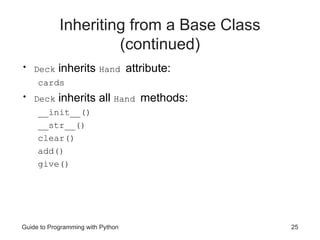

![Guide to Programming with Python 27
Extending a Derived Class (continued)
def deal(self, hands, per_hand = 1):
for rounds in range(per_hand):
for hand in hands:
if self.cards: # if len(self.cards) > 0
top_card = self.cards[0]
self.give(top_card, hand)
else:
print "Out of cards!"](https://image.slidesharecdn.com/ch09-241018043703-f8fb98a9/85/Programming-in-python-and-introduction-ppt-27-320.jpg)

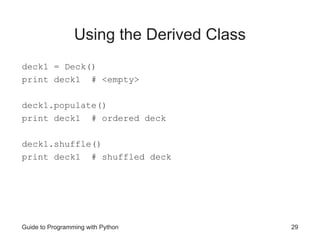
![Guide to Programming with Python 30
Using the Derived Class (continued)
my_hand = Hand()
your_hand = Hand()
hands = [my_hand, your_hand]
deck1.deal(hands, per_hand = 5)
print my_hand # 5 alternating cards from deck
print your_hand # 5 alternating cards from deck
print deck1 # deck minus first 10 cards
deck1.clear()
print deck1 # <empty>
playing_cards2.py](https://image.slidesharecdn.com/ch09-241018043703-f8fb98a9/85/Programming-in-python-and-introduction-ppt-30-320.jpg)

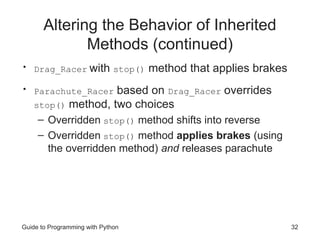

![Guide to Programming with Python 34
Creating a Base Class
(Same as before)
class Card(object):
""" A playing card. """
RANKS = ["A", "2", "3", "4", "5", "6", "7",
"8", "9", "10", "J", "Q", "K"]
SUITS = ["c", "d", "h", "s"]
def __init__(self, rank, suit):
self.rank = rank
self.suit = suit
def __str__(self):
reply = self.rank + self.suit
return reply](https://image.slidesharecdn.com/ch09-241018043703-f8fb98a9/85/Programming-in-python-and-introduction-ppt-34-320.jpg)



